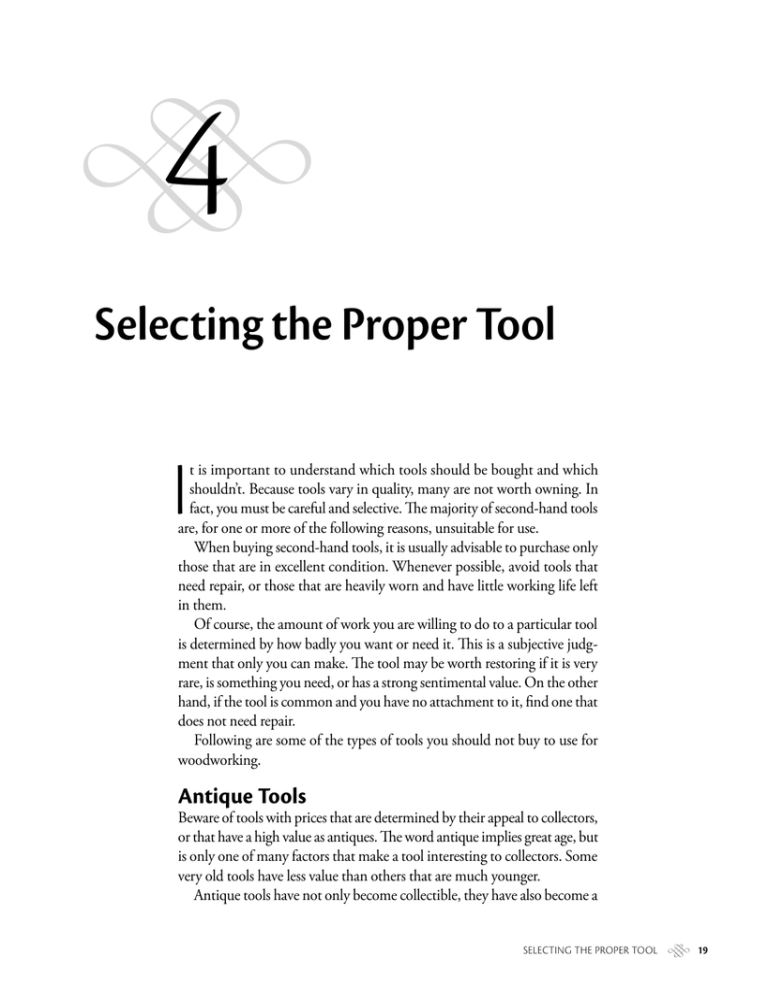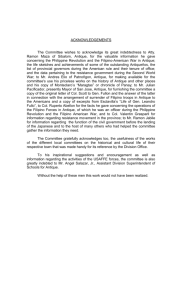Selecting the Proper Tool
advertisement

4 � Selecting the Proper Tool I t is important to understand which tools should be bought and which shouldn’t. Because tools vary in quality, many are not worth owning. In fact, you must be careful and selective. The majority of second-hand tools are, for one or more of the following reasons, unsuitable for use. When buying second-hand tools, it is usually advisable to purchase only those that are in excellent condition. Whenever possible, avoid tools that need repair, or those that are heavily worn and have little working life left in them. Of course, the amount of work you are willing to do to a particular tool is determined by how badly you want or need it. This is a subjective judgment that only you can make. The tool may be worth restoring if it is very rare, is something you need, or has a strong sentimental value. On the other hand, if the tool is common and you have no attachment to it, find one that does not need repair. Following are some of the types of tools you should not buy to use for woodworking. Antique Tools Beware of tools with prices that are determined by their appeal to collectors, or that have a high value as antiques. The word antique implies great age, but is only one of many factors that make a tool interesting to collectors. Some very old tools have less value than others that are much younger. Antique tools have not only become collectible, they have also become a SELECTING THE PROPER TOOL � 19 means of investment. As with fine art, antique furniture, and coins and stamps, novices should be very careful when buying antique tools. If you do not understand the circumstances that determine value, you could lose a great deal of money. It is very possible to pay much more for an item than it is worth—much more than you would receive if you decided to resell it. Once you own an antique tool, be careful as to how you use it. If the ordinary tuning that is necessary before any tool (old or brand new) can be put to use is not done properly, it can lower the value of an antique tool. There is one final reason why woodworkers should leave antique tools to the collector: their recent high prices have inevitably attracted dealers selling fake “antiques” In this market a little knowledge is dangerous. The novice soon hears of the high prices paid for rare tools, but he at this point has not yet learned how to identify a real antique and may purchase a fake that is being sold at what seems a bargain price. In the first chapter, I mentioned the advantages of secondhand tools; they are usually better quality, and often less expensive. These characteristics do not necessarily apply to antique tools. So, unless you want to collect antique tools and invest the time necessary to learn about them and their prices, stay away from them. Damaged Tools Avoid tools that need major repairs. Repair work often has to be done by another craftsman who is capable of doing work that you yourself cannot do, for example, a machinist or a blacksmith. This means that the tool’s real price becomes the sum of what you paid for it plus the cost of the repair. And even if you can do the work yourself, your time has value and has to be factored into the total cost. Seldom does a repair make economic sense, although there are always exceptions. I recently made some repairs to a 3/8-inch wooden dado plane that had been purchased by a woodworker friend. The front of the sole (a narrow wooden strip, no wider than the dado it cuts) had been snapped off and was missing. He purchased the damaged plane for slightly less than ten dollars, deciding not to buy an identical undamaged dado plane that cost slightly less than 30 dollars. I made the repair by cutting a shallow rabbet and gluing in a new piece of 3/8-inch beech. The repair took about 15 minutes and saved him a considerable amount of money. Tools with Missing Parts Most second-hand tools have not been used for years, even decades. In the meantime, they were either stored or left lying around. During this period of disuse tools lose removable parts. The more parts a tool has (such as a combination plane with all its separate cutters), the greater the chances that all the parts will not be with the tool when you acquire it. If you do buy a tool that is incomplete, one solution is to duplicate the missing part. This is often more difficult and time consuming than making a repair. If the part is made of wood, you, as a woodworker, are more likely to be able to make it. Replacing a part that is made of forged or cast metal, however, requires skills that most woodworkers do not have. Another solution is to find a replacement part. This means that you will not be able to use the tool until you find another identical, incomplete tool or a damaged tool that can be cannibalized. Once you have found this tool, you have to purchase it. The price of your one complete tool will be the sum of the two incomplete ones. The two purchases, plus the effort that went into finding them, seldom add up to a bargain. Although I try to avoid buying incomplete tools, I occasionally find something that I want badly enough to justify ignoring my own advice. In anticipation of this possibility, I purchase loose items such as molding plane irons, ferrules, saw nuts, and various types of handles, and stockpile them. Most tool dealers have a “dollar box” where anything in the box is sold at a fixed price, often one dollar. Loose parts are often tossed into the dollar box. I never leave a shop without taking a moment to paw through the box’s contents. Avoid any tool that has a badly chipped or cracked casting. However, sometimes a tool is so essential that such defects have to be accepted. For example, I own an old Bailey cast-iron bench rabbet plane (see Chapter 14). The casting and the machining on this plane are 20 � RESTORING, TUNING & USING CLASSIC WOODWORKING TOOLS much finer than on the comparable plane that is made today. Unfortunately, the body was cracked just above the opening in the cheeks. The only craftsman I could find with the skill to repair it was a gunsmith. He was able to braze it so that it worked as well as when new. However, I did have to take the time to find someone who could do the repair and to deliver and pick up the tool; I also had to pay for the work. Had the plane not been such a good tool, I never would have invested that much time, effort, and money on it. The decision to repair a tool or to replace a missing part is subjective and must be made by you. I will invest more time and effort into repairing a tool that I either need, is unusual, particularly appeals to me, or has sentimental value. SELECTING THE PROPER TOOL � 21

